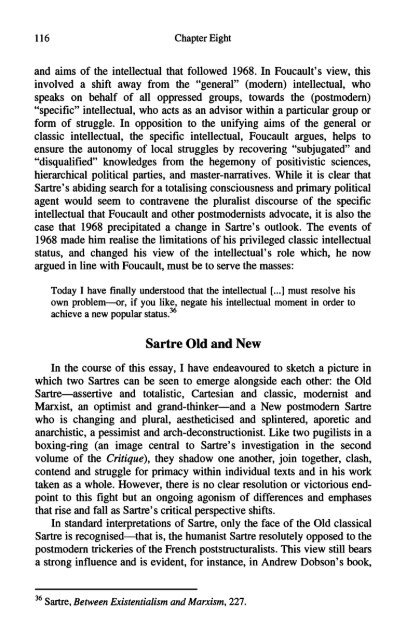Sartre's second century
Sartre's second century
Sartre's second century
Create successful ePaper yourself
Turn your PDF publications into a flip-book with our unique Google optimized e-Paper software.
116 Chapter Eight<br />
and aims of the intellectual that followed 1968. In Foucault's view, this<br />
involved a shift away from the "general" (modern) intellectual, who<br />
speaks on behalf of all oppressed groups, towards the (postmodern)<br />
"specific" intellectual, who acts as an advisor within a particular group or<br />
form of struggle. In opposition to the unifying aims of the general or<br />
classic intellectual, the specific intellectual, Foucault argues, helps to<br />
ensure the autonomy of local struggles by recovering "subjugated" and<br />
"disqualified" knowledges from the hegemony of positivistic sciences,<br />
hierarchical political parties, and master-narratives. While it is clear that<br />
<strong>Sartre's</strong> abiding search for a totalising consciousness and primary political<br />
agent would seem to contravene the pluralist discourse of the specific<br />
intellectual that Foucault and other postmodernists advocate, it is also the<br />
case that 1968 precipitated a change in <strong>Sartre's</strong> outlook. The events of<br />
1968 made him realise the limitations of his privileged classic intellectual<br />
status, and changed his view of the intellectual's role which, he now<br />
argued in line with Foucault, must be to serve the masses:<br />
Today I have finally understood that the intellectual [...] must resolve his<br />
own problem—or, if you like, negate his intellectual moment in order to<br />
achieve a new popular status. 36<br />
Sartre Old and New<br />
In the course of this essay, I have endeavoured to sketch a picture in<br />
which two Sartres can be seen to emerge alongside each other: the Old<br />
Sartre—assertive and totalistic, Cartesian and classic, modernist and<br />
Marxist, an optimist and grand-thinker—and a New postmodern Sartre<br />
who is changing and plural, aestheticised and splintered, aporetic and<br />
anarchistic, a pessimist and arch-deconstructionist. Like two pugilists in a<br />
boxing-ring (an image central to <strong>Sartre's</strong> investigation in the <strong>second</strong><br />
volume of the Critique), they shadow one another, join together, clash,<br />
contend and struggle for primacy within individual texts and in his work<br />
taken as a whole. However, there is no clear resolution or victorious endpoint<br />
to this fight but an ongoing agonism of differences and emphases<br />
that rise and fall as <strong>Sartre's</strong> critical perspective shifts.<br />
In standard interpretations of Sartre, only the face of the Old classical<br />
Sartre is recognised—that is, the humanist Sartre resolutely opposed to the<br />
postmodern trickeries of the French poststructuralists. This view still bears<br />
a strong influence and is evident, for instance, in Andrew Dobson's book,<br />
Sartre, Between Existentialism and Marxism, 227.
















